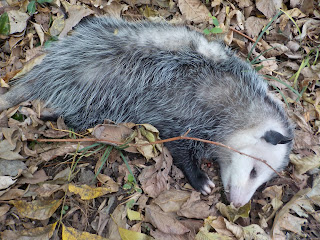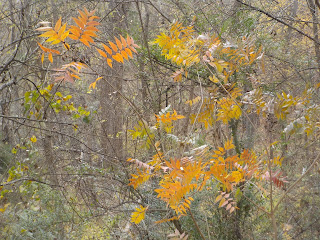The past week of November has been a delightful time to be in the Woods. Cold nights and cool mornings have eliminated worries about ticks and other arthropod pests. The Woods turned gold. For two days, I could stand and watch leaves raining down.. no wind.. leaves completing their abscission and dropping, floating down, thousands and thousands. Soundless, or maybe just the slightest rasp as each leaf joined the leafy forest floor.
The Woods are dry with another La Nina controlling central Oklahoma weather. The two week Mesonet picture shows zero precipitation here for this month. The prolonged drying created deep open cracks and fissures in the dry forest soil. Who knows how deep these fissures may extend, and what communities of soil invertebrates, springtails, rove beetles, oribatids, rollie pollies, daddy-longlegs and other creatures may shelter there on cold nights? I remember an earlier dry La Nina when a sudden substantial rain finally began to fill the dry soil fissures. I watched as inch deep pools bubbled for two days with the displacement of deep air as water replenished the soil. Forest trees elms, bur oaks, pecan, southern hackberry, walnut, coffee tree, willow, black haw, sycamore, hickory and more need a deep winter drink. They've had a good year of growth from the spring and early summer but are going dormant now with their roots dry.
This fall there are changes in the Woods. The usual herd of around a half dozen to a dozen white-tailed deer that normally shelter in the Woods during the hunting season is now down to two. I found their beds yesterday morning walking the trail up to the North Rim. There were two fresh depressions, leaves flattened against the soil, about 3 feet apart, where the two deer had spent the night. The new construction and fencing on the south boundary limits the movement of wildlife in and out of the Woods from the wilder river lands. I saw the first cottontail rabbit I'd seen in the Woods in months, when it burst out of a brush pile at my feet and dashed away uphill into the forest.
There is also death and new life visible, surprises to be found. I was surprised to see a beautiful, recently dead opossum, laying above the trail by the NW pond. It looked so peaceful. I sat and admired it, the details of its coat and feet and head for a quarter of an hour. There was a shed snake skin, looked like maybe a small green snake, thin and about 6 inches. It has been more than two years since I've seen a snake in Oliver's Woods. I know they must be there, but perhaps not common. There were also small clusters of downy feathers, slate gray and white just east of the big catalpa trees. A predator had taken a junco for a meal. There is surprising new life (puzzling) in the Woods too. A single pair of Missouri violets in full bloom, cream white petals, tinged lilac blue with darker sharp lines marking the way to the nectaries of the flower. In the SE Woods, dozens of mulberry trees and red elms with fully flushed bright green big new leaves in the lower canopy. Stealing the opportunity for a little more photosynthesis with the continued mild November days and sudden increase in available light after the fall of the upper canopy leaves.
On the higher slopes above the East Pond the dully incandescent orange of Chinese pistache tree leaves and the ragged empty crowns of the big pecans and hackberries show they are ready for the coming season.



No comments:
Post a Comment